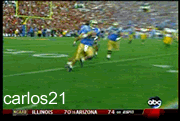
The 40-yard dash has become the highlight of every pre-draft workout. From the NFL scout combine to individual pro-days, Americans have developed a fascination for watching prospects stripped of pads, and often lighter than their playing weight, run full speed in a straight line. And regardless of what some critics may believe, this measurement of speed, depending on position, does have an impact on draft status.
Too often, there’s the argument that 40-times don’t factor in the equation for draft positioning, and they’ll support their stance with names of speedy draft busts and slower prospects that rose to stardom. But honestly, for ever story of failure, you’ll find several others of success. They argue that recorded times in a straight line don’t matter in accordance to where a player is selected, but they do. You can fill out your personal mock and choose not to give a certain player a first round projection, by ignoring recorded speeds, but it will stray from the league’s current selection pattern. 40-times may or may not be the proper method for evaluating future talent, but in terms of draft positioning, history proves there is a significant impact.
Today’s NFL rebuilds with speed, so I tire of references to old school slugs and stardom. Those stories hold as much weight as the passing games of those periods. In today’s game, the fastest guy on the track isn’t necessarily the first off the board, but it’s foolish to believe speed can’t catapult a player to a more prosperous draft position. Do 4.3 players go in the 4th and 5th rounds? Of course they do. But let that same player run a 4.5 or higher, depending on his position, and watch him fall to the seventh or become an undrafted free agent.
The difference between Chris Johnson being selected in the first and second rounds of last year’s draft was his 4.24 at the scout combine. Also, with the more popular receivers from the more popular schools projected as first round prospects, none left the board in the opening round, and Houston’s Donnie Avery, and his 4.2 speed, became the first off the board in the second. Before Avery and Johnson ran that straight line, they were projected lower than several others at their position. And likewise, Oklahoma’s Malcolm Kelly was a top receiving prospect, until he appeared sluggish on the track.
For some positions, it’s ridiculous to even time the the 40-yard dash. Recording the speed of a kicking prospect is irrelevant, unless you’re purposely drafting with the expectations of a poor kicking game, which leaves him running down returners on a path to the end zone or defenders that block and scoop kicks. And what about 300 pound linemen or the speed of linebackers, does it matter? Not so much, as far as the end result, but there is more than one measurement on that 40-yard track.
The NFL Network brings the combine into our living rooms, and we watch athletes run a track to a succession of beeps. The final beep is the number announced, giving us the official 40-time. But for some positions, it’s the first beep that is most important, as it measures the explosion. For Example, at the combine, USC’s Clay Matthews made a push for first round selection. Along with his great performance in drills, he also ran well on the track. Though his official time was 4.62, it’s less significant than his time in the first 10 yards.
Matthews clocked 1.49 at the first beep. In comparison, Percy Harvin recorded 1.47, and Darius Heyward-Bey, who dazzled the combine with a 4.3 finish, clocked 1.44 for the first 10 yards. For teams looking for an outside pass rusher, position drills display the footwork and strength, but it’s the first 10 yards of the 40-yard dash that gives them a sense of the explosion. It’s that measure of burst that added to Matthews’ physical dimensions to make him a legitimate first round prospect.
Are 40-times overrated? Possibly. But they are without a doubt a proven element in prospect alignment, and enough of a factor to push players to shed weight and hire trainers for the single event.










